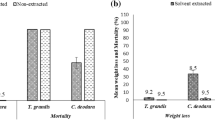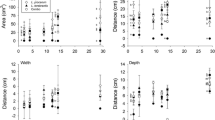Abstract
Few studies have focused on interactions between subterranean termites and the ophiostomatoid fungal associates of pine bark beetles or root feeding weevils. Field stake tests were employed at four locations throughout Mississippi to determine the feeding preference of subterranean termites for blue-stained, unstained, and partially decayed southern pine sapwood stakes. This study also utilized wood decayed by Gloeophyllum trabeum, a fungus previously shown to elicit a positive subterranean termite feeding response, as a positive control. Stakes inoculated with G. trabeum received significantly more attacks than all other treatments after 16 weeks. Of the stakes attacked by subterranean termites, stakes inoculated with Ophiostoma minus were degraded faster than any other treatment. Subterranean termite preference for stakes treated with either of two Leptographium spp. and the untreated negative controls did not differ; however, each was fed upon less than all other treatments. The feeding rate on stakes inoculated with O. ips and G. trabeum being fed upon by subterranean termites was not significantly different. These results represent the first evidence of wood containing non-structurally degrading fungi (O. ips and O. minus) eliciting a feeding preference from subterranean termites greater than that of decayed wood. The implications of these results are particularly relevant to pine forest ecology, nutrient cycling, subterranean termite control, and the utilization of blue-stained southern pine building products in the southeastern U.S.


Similar content being viewed by others
References
Abraham LD, Breuil C (1996) Isolation and characterization of subtilisin-like serine proteinase secreted by the sap-staining fungus Ophiostoma piceae. Enzyme Microb Technol 18:133–140
Abraham LD, Roth A, Saddler JN, Brueil C (1993) Growth, nutrition, and proteolytic activity of the sap-staining fungus Ophiostoma piceae. Can J Bot 71:1224–1230
Abraham LD, Hoffman B, Gao Y, Breuil C (1998) Action of Ophiostoma piceae on proteinase and lipase on wood nutrients. Can J Microbiol 44:698–701
Amburgey TL (1979) Review and checklist of the literature on interactions between wood-inhabiting fungi and subterranean termites: 1960–1978. Sociobiology 4:279–296
Amburgey TL, Beal RH (1977) White rot inhibits termite attack. Sociobiology 3:35–38
Amburgey TL, Smythe RV (1977) Factors influencing termite feeding on brown-rotted wood. Sociobiology 3:3–12
(AWPA) American Wood Protection Association (2009) AWPA book of standards. AWPA, Birmingham
Ballard RG, Walsh MA, Cole WE (1983) The penetration and growth of blue-stain fungi in the sapwood of lodgepole pine attacked by mountain pine beetle. Can J Microbiol 62:1724–1729
Becker G (1976) Termites and fungi. Mater Org 3:465–478
Breuil C, Huang J (1994) Activities and properties of extracellular proteinases produced by staining fungi grown in protein-supplemented liquid media. Enzyme Microb Technol 16:602–607
Breuil C, Yagodnik C, Abraham L (1995) Staining fungi grown in softwood produce proteinases and aminopeptidases. Mater Org 29:15–25
Brush TS, Farrell RL, Ho C (1994) Biodegradation of wood extractives from southern yellow pine by Ophiostoma piliferum. Tappi J 77:155–159
Cornelius ML, Daigle DJ, Connick WJ Jr, Parker A, Wunch K (2002) Responses of Coptotermes formosanus and Reticulitermes flavipes (Isoptera: Rhinotermitidae) to three types of wood rot fungi cultured on different substrates. J Econ Entomol 95:121–128
Drooze AT (1985) Insects of eastern forests. Misc. Publ. 1426, Department of Agriculture, Washington DC
Esenther GR, Beal RH (1979) Termite control: decayed wood bait. Sociobiology 4:215–222
Esenther GR, Allen TC, Casida JE, Shenefelt RD (1961) Termite attractant from fungus-infected wood. Science 134:50
Gao D-R (1985) Use of attractants in bait toxicants for the control of Coptotermes formosanus Shiraki in China. In: Tamashiro M, Su N-Y (eds) Biology and control of the Formosan subterranean termite. Research Extension Series 083. College of Tropical Agriculture and Human Resources, University of Hawaii, Honolulu, pp 53–57
Gao Y, Breuil C (1995) Extracellular lipase production by a sapwood-staining fungus, Ophiostoma piceae. World J Microbiol Biotechnol 11:638–642
Gao Y, Breuil C (1998) Properties and substrate specificities of an extracellular lipase purified from Ophiostome piceae. World J Microbiol Biotechnol 14:421–429
Gardes M, Bruns TD (1993) ITS primers with enhanced specificity to basidiomycetes—applications to the identification of mycorrihizae and rusts. Mol Ecol 2:113–118
Goheen DJ (1976) Verticiladiella wageneri on Pinus ponderosa: epidemiology and interrelationships with insects. Ph.D. thesis, University of California, Berkeley
Grace JK, Wilcox WW (1988) Isolation and trail-following bioassay of a decay fungus associated with Reticulitermes hesperus Banks (Isoptera: Rhinotermitidae). Pan-Pac Entomol 64:243–249
Harrington TC, Cobb FW Jr (1988) Leptographium root diseases of conifers. APS Press, St. Paul
Hendee EC (1934) The association of termites and fungi. In: Kofoid CA (ed) Termite and termite control, 2nd edn. University of California Press, Berkeley, pp 105–116
Kirker GT, Wagner TL, Diehl SV (2012) Relationship between wood-inhabiting fungi and Reticulitermes spp. in four forest habitats of northeast Mississippi. Int Biodeter Biodegr 72:18–25
Lenz M, Ruyooka DBA, Howick CD (1980) The effect of brown and white rot fungi on wood consumption and survival of Coptotermes lacteus (Froggatt) (Isoptera: Rhinotermitidae) in a laboratory setting. J Appl Entomol 89:344–362
Lenz M, Amburgey TL, Zi-Rong D, Mauldin JK, Preston AF, Rudolph D, Williams ER (1991) Interlaboratory studies on termite-wood decay fungi associations: II. Response of termites to Gloeophyllum trabeum grown on different species of wood (Isoptera: Mastotermitidae, Termopsidae, Rhinotermitidae, Termitidae). Sociobiology 18:203–254
Little NS, Riggins JJ, Schultz TP, Londo AJ, Ulyshen MD (2012a) Feeding preference of native subterranean termites (Isoptera: Rhinotermitidae: Reticulitermes) for wood containing bark beetle pheromones and blue-stain fungi. J Insect Behav 25:197–206
Little NS, Blount NA, Londo AJ, Kitchens SC, Schultz TP, McConnell TE, Riggins JJ (2012b) Preference of Formosan Subterranean Termites for Blue-Stained Southern Yellow Pine Sapwood. J Econ Entomol 105:1640–1644
Matsumura F, Coppel HC, Tai A (1968) Isolation and identification of termite trail-following pheromone. Nature 219:963–964
Matsumura F, Tai A, Coppel HC (1969) Termite trail-following substance, isolation and purification from Reticulitermes virginicus and fungus-infected wood. J Econ Entomol 62:599–603
Matsumura F, Nishimoto K, Ikeda T, Coppel HC (1976) Influence of carbon sources on the production of the termite trail-following substance by Gloeophyllum trabeum. J Chem Ecol 2:299–305
Matsuo H, Nishimoto K (1974) Response of the termite Coptotermes formosanus (Shiraki) to extract fractions from fungus-infected wood and fungus mycelium. Mater Org 9:225–238
Ohmura W, Tokoro M, Tsunoda K, Yoshimura T, Takahashi M (1995) Termite trail-following substances produced by brown-rot fungi. Mater Org 29:133–146
Paine TD, Birch MC, Švihra P (1981) Niche breadth and resource portioning by four sympatric species of bark beetles (Coleoptera: Scolytidae). Oecologia 48:1–6
Paine TD, Raffa KF, Harrington TC (1997) Interactions among scolytid bark beetles, their associated fungi, and live host conifers. Annu Rev Entomol 42:179–206
Payne TL (1980) Life history and habits. In: Thatcher RC, Searcy JL, Coster JE, Hertel GD (eds) The Southern Pine Beetle, Tech. Bull. 1631, Department of Agriculture Forest Service, Expanded Southern Pine Beetle Research and Applications Program, Washington, DC, pp 7–28
Rane KK, Tattar TA (1987) Pathogenicity of blue-stain fungi associated with Dendroctonus terebrans. Plant Dis 71:879–883
Rumbold CT (1931) Two blue-staining fungi associated with bark beetle infestation of pines. J Agric Res 43:847–873
Rust MK, Haagsma K, Nyugen J (1996) Enhancing foraging of western subterranean termites (Isoptera: Rhinotermitidae) in arid environments. Sociobiology 28:275–286
Sands WA (1969) The association of termites and fungi. In: Krishna K, Weesner FM (eds) Biology of termites, vol 1. Academic, New York, pp 495–524
SAS Institute (2009) Version 9.2. SAS Institute, Cary
Schirp A, Farrell RL, Kreber B, Singh AP (2003) Advances in understanding the ability of sapstaining fungi to produce cell wall-degrading enzymes. Wood Fiber Sci 35:434–444
Smythe RV, Coppel HC, Lipton SH, Strong FM (1967) Chemical studies of attractants associated with Reticulitermes flavipes and R. virginicus. J Econ Entomol 60:228–233
Tisdale RA, Nebeker TE, Hodges JD (2003) The role of oleoresin flow in the induced response of loblolly pine to a southern pine beetle associated fungus. Can J Bot 81:368–374
Valiev A, Ogel ZB, Klepzig KD (2009) Analysis of cellulose and polyphenol oxidase production by southern pine beetle associated fungi. Symbiosis 49:37–42
Wagerner WW, Mielke JL (1961) A staining fungus root disease of ponderosa, Jeffrey, and pinyon pines. Pland Dis Rep 45:831–835
Waller DA, La Fage JP, Gilbertson RL, Blackwell M (1987) Wood-decay fungi associated with subterranean termites (Rhinotermitidae) in Louisiana. In Proceedings, 89th Conference of the Entomological Society of Washington, pp 417–424
Whitney HS (1971) Association of Dendroctonus ponderosae (Coleoptera: Scolytidae) with blue-stain fungi and yeasts during brood development in lodgepole pine. Can Entomol 103:1495–1503
Wood DL (1982) The role of pheromones, kairomones, and allomones in the host selection and colonization behavior of bark beetles. Annu Rev Entomol 27:411–446
Zoberi MH, Grace KG (1990) Fungi associated with the subterranean termite Reticulitermes flavipes in Ontario. Mycologia 82:289–294
Acknowledgements
This research was funded by the USDA Forest Service Forest Health Protection and Southern Research Station, the Mississippi Forestry Commission, the Mississippi Agricultural and Forestry Experiment Station, and the Mississippi Forest and Wildlife Research Center. The authors would like to thank Southeastern Timber Products of Ackerman, MS, for donating the lumber for this project.
Author information
Authors and Affiliations
Corresponding author
Rights and permissions
About this article
Cite this article
Little, N.S., Schultz, T.P., Diehl, S.V. et al. Field Evaluations of Subterranean Termite Preference for Sap-Stain Inoculated Wood. J Insect Behav 26, 649–659 (2013). https://doi.org/10.1007/s10905-013-9380-x
Revised:
Accepted:
Published:
Issue Date:
DOI: https://doi.org/10.1007/s10905-013-9380-x




